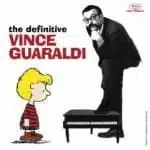
Put yourself in Lee Mendelson’s position for a moment. Imagine it’s 1963 and you’re a television documentary producer driving across the Golden Gate Bridge, thinking about the film you’re developing in collaboration with the creator of the Peanuts comic strip, Charles Schulz. What type of music would fit the setting of the story of Charlie Brown, his pals and his ever-loyal dog?
Upon flipping on a jazz station on the radio [because there was still jazz on the radio in ’63], pianist Vince Guaraldi’s “Cast Your Fate to the Wind” comes through your speakers. The infectious lilt of Monty Budwig’s buttery bass and Colin Bailey’s gently brushed drums mixes with Guaraldi’s rolling piano, which wavers between a slinky Latin groove and a bluesy bounce. It’s three minutes of pure musical joy, and then you realize it: this man has the feeling, the imagination and the perfect idea of how to translate childhood whimsy into a timeless track.
One day later, you’re having lunch with the formidable pianist to propose that he compose the soundtrack for the film. One week later, you receive a call from Guaraldi; he sets the receiver by his piano, and suddenly the theme of “Linus and Lucy” emerges from the other end of the phone. It’s the “a-ha!” moment so many producers long for, yet your delight is quickly deflated as another two years pass before your film is finally picked up by a sponsor with a connection to an established American institution: Coca-Cola. An individual at the soda empire’s ad agency proposes the idea of a Charlie Brown Christmas Special, again with music written by Vince Guaraldi. And so a new American institution was born…
+ + +
Many years before A Charlie Brown Christmas ever hit the airwaves and Americans fell hard and fast for the lovable group of kids, Vince Guaraldi — the man who came to be dubbed “Dr. Funk” by his colleagues — was churning out compelling compositions equally cheerful and uplifting as they were contemplative and melancholic. You can even hear traces of Peanuts tunes in his fingers that pre-dated the music of the iconic Schulz comic, and in the tunes that followed. With steady resolve to “make it”, the self-described “reformed boogie-woogie player” became an establishment himself in San Francisco’s 1950s jam sessions, sitting in with visiting name groups and even earning a spot recording with Latin jazz stalwart Cal Tjader — at age 23.
Gigs with established bandleaders aside, including a stint with Woody Herman, Guaraldi’s finest work is compiled here on The Definitive Vince Guaraldi, featuring recordings by his first trio with bassist Dean Reilly and guitarist Eddie Duran; his late 1950s trio with Budwig and Bailey; explorations of The Latin Side of Vince Guaraldi with Duran, bassist Fred Marshall and drummer Jerry Granelli; the Brazilian guitarist Bola Sete and several other notable musicians.
Featuring alto saxophonist Jerry Dodgion, opener “Calling Dr. Funk” prowls along like the score for a spy movie or an old-school detective drama. “Never Never Land” features Guaraldi unaccompanied and inspiring — you can almost picture him sitting alone at the piano, head bowed as he investigates the keys with delicate intensity. “Manha de Carnaval” is hushed, shadowed and sublime. Moving versions of “Moon River” and “On Green Dolphin Street” spill over with remarkable alternations between deep, soul-stirring chords and spine-tingling single note runs. Uptempo numbers like “Jitterbug Waltz”, “Work Song”, “The Girl from Ipanema”, and “El Matador” showcase Guaraldi’s piano work swinging, swaying, and slipping in and out of the arrangements with a deft touch.
And then there’s the Peanuts work. “Oh, Good Grief” happily bounces along with childlike innocence; “Linus and Lucy” shuffles along with playful and pensive moments; and in “Christmas Time is Here”, Guaraldi’s almost-tearful delivery of the melody gracefully skates over the top of the sparse, muted rhythm laid down by Marshall and Granelli. Previously unreleased tracks “Autumn Leaves” and “Blues for Peanuts” are simple and stunning, while the St. Paul’s Church of San Rafael choir’s turn on “Theme to Grace” is stunning and spiritual.
Vince Guaraldi almost quit playing the piano entirely when sharing the intermission piano duties with Art Tatum at San Francisco’s Black Hawk club in the early 1950s. Thankfully, he didn’t, and continued to search for his own voice, a journey that led him to discover a sound that has resonated through the years in the minds and hearts of listeners. The buoyant brilliance of his tunes transport you to another place — and can even make you feel like a kid again, or like dancing on a piano. Isn’t that what all music is supposed to do?
